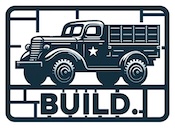As part of the Cylon Raider Diorama, I needed springs…. those kind that the Mak. guys add to their armored suits to look like power cables. I’m running electrical wires across the deck and wanted to hide them in a “big ass power cable” and springs was the easiest way to get there. The problem was… the way I wanted to run electrical wires required a spring bigger than I could find easily. (Read more about this on the Cylon Raider project page)
I had previously purchased a bunch of beautiful springs from HobbyLink Japan. They were relatively inexpensive, long enough for my needs, and arrived quickly. But… there was no way they were big enough to fit the large wire I was using. I search Grainger, McMaster-Carr, and a variety of spring selling online businesses. I even ordered a few off Amazon and realized I’d gone way wrong. I did learn the different between a compression and extension spring (these are extensions). But I still came up short. Someone in Scale Modelers Critique Group on Facebook mentioned I could make my own. Since I’d run out of options (and patience), I started where so many of us do… YouTube. I found a very helpful video about how you make springs at home. Watch the video for the basics, but I’ll add a few tips of my own.
What you’ll need
- A drill
- A clamp to hold the drill stable
- A metal rod the size of your spring (more on the sizing in a second)
- Music wire (I used .016 from amazon)
- Wire cutters
- A pair of heavy gloves
I also used my Proxxon suction vise and a shop towel. These disposable blue shop towels are amazing. Thick enough to hold up, no so think they are spongy, and shed almost nothing.
Steps to make the spring
Watch the video to get more details, but here’s the basic rundown I used.
- Stretch out a long length of wire, much more than you think you’ll need. I had to take it out of the box to get it ready to spool up because the wire in my box was all jacked up.
- Chuck up the metal rod in your drill. Get it nice and tight. (I’ve seen people use wood dowel, but at the sizes we’re working in, this is going to snap instantly) Then set the drill to reverse direction.
- Run.the wire through a vise off to the right side of you and a few feet back. Put the shop town in between the jaws, put the wire in there too, then clamp it down. Use as much pressure as you can while still being able to pull the wire through. Tension is your friend! You’re creating tension on the music wire at all times to get a smooth, even twist. However you can figure out the tension situation, do it. (I had my wife stand at the other end of the garage with a pair of vise grips on the end of the wire and hold tension… it worked, but the mounted vise option is better and requires less coordination)
- Take one end of the wire and put a 90 degree bend in it. Shove it into the chuck so that when the drill starts spinning, it grabs ahold of the wire.
- Here’s where things get started: While applying tension on the wire right near the metal rod, start the drill slowly until it starts winding the spring consistently. Don’t worry about the first few turns.. they’re going to be ugly and you just cut those off.
- Holding the drill speed consistent (I didn’t wear a glove on my left hand to more easily control the speed and I wear one on the right to ensure I don’t get wire burn on my fingers) the wire will start to wind around the metal bar. You’re going to keep moving your gloved hand to the right (away from the chuck) as the spring winds longer and longer. But this is a SLOW move to the right, almost imperceptible. Consistent speed, ensuring an easy flow of the wire through the vise without getting bound up, and NOT STOPPING until you’re done with the length of spring you need are all critical.
- Once you’ve gotten near the end of your unwound music wire, stop the drill. Don’t run out the end of the wire… leave a little hanging. Again you’ll cut this off. As soon as you let go, get your hand out of the way. It will unwind a bit but will generally hold it’s round shape. This is where you have to experiment with the wire gauge and metal bar diameter to get the size spring you want to end up with.
- Slide the spring off the rod, trim the edges, and enjoy!
Tips
- The music wire can get bound up really easily. If you have someone who can help ensure it’s feeding well, that’s a huge help. Make sure they use gloves too… you don’t want to accidently juice the drill and slice their fingers.
- Practice. A lot. It takes a minute to figure out the right pace, tension, and technique to get a consistent, long spring. You’re going to make some mistakes. I probably burned through half a box of the music wire just trying to figure out what the hell I was doing.
- It bears repeating: you’re going to have to find the right rod and the right gauge of music wire to end up with the right size spring.
And if you don’t really need to make your own springs, just buy them. This was a requirement for my project, but the pre-made springs are wonderful, cheap, and easy to obtain.










Leave A Comment